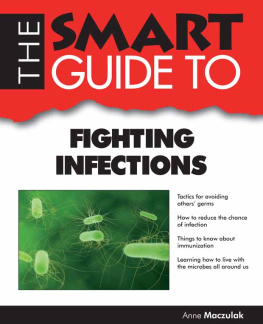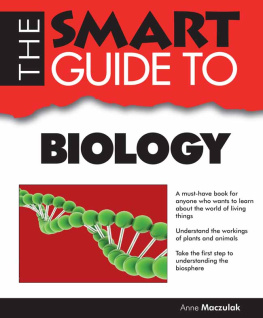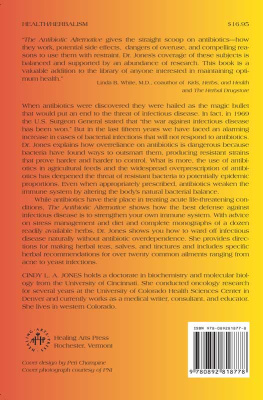
The Smart Guide To Fighting Infections
Published by
Smart Guide Publications, Inc.
2517 Deer Chase Drive
Norman, OK 73071
www.smartguidepublications.com
Copyright 2012 by Anne Maczulak. All rights reserved. No part of this book, including interior design, cover design, illustrations and icons may be reproduced or transmitted in any form or stored in a retrieval system, or transmitted by any means, electronic, mechanical, photocopying, recording, or otherwise, without written permission from the publisher. Although every precaution has been taken in the preparation of this book, the publisher and author assume no responsibility for errors or omissions. The author and publisher specifically disclaim any responsibility for any liability, loss, or risk, personal or otherwise, which is incurred as a consequence, directly or indirectly, of the use and application of any of the contents of this book.
For information, address: Smart Guide Publications, Inc. 2517 Deer Creek Drive, Norman, OK 73071
SMART GUIDE and Design are registered trademarks licensed to Smart Guide Publications, Inc.
International Standard Book Number: 978-1-937636-19-7
Library of Congress Catalog Card Number:
11 12 13 14 15 10 9 8 7 6 5 4 3 2 1
Printed in the United States of America
Cover design: Lorna Llewellyn
Copy Editor: Ruth Strother
Back cover design: Joel Friedlander, Eric Gelb, Deon Seifert
Back cover copy: Eric Gelb, Deon Seifert
Illustrations: James Balkovek
Production: Zo Lonergan
Indexer: Cory Emberson
V.P./Business Manager: Cathy Barker
INTRODUCTION
Fighting Infection
This Book
What do we mean when we say we are going to fight infection? It could mean driving from the body an illness that has taken hold of you and making you feel miserable. You know something is wrong by your urge to sneeze or cough, headache and fatigue that make the simplest tasks a challenge, and by an ominous rumbling in the bowels. You would certainly do all in your power to get rid of such a feeling.
While you may resort to chicken soup and a good nights sleep, your body is waging furious warfare against the bug you have caught. This book gives you tips on bolstering your bodys natural defenses against mild and more serious infections.
A second important piece to fighting infection exists, however, and it involves steps everyone should take to prevent germs from getting into the body in the first place. These prevention steps are more effective in maintaining good health than anything else you can do.
This Smart Guide to Fighting Infections tells you how to make a two-pronged attack against germs. First, it covers the actions you can take to keep germs from getting near you. But some germs will get through from time to time; its inevitable. Therefore, this book also gives you information on what to do to help your body eliminate infection. You can make choices that help your body annihilate a germ as quickly as possible.
The 24 chapters in this book guide you through the basics of infection, including the microbes that cause infections and the diseases that sometimes develop from mild, localized infections. After learning the basics of the infection process and microbes, you will learn about toxins, which are poisons that microbes make. You will become familiar with the ways microbes get into your body and how they leave. You will also meet the microbes that live in harmony with you for most of your life but can betray you and cause illness if given the right opportunity.
This Smart Guid e presents the big picture of epidemiology, or how scientists monitor the movement of disease through our population. The book gives you vital details on germ transmission. You cannot stop germs from reaching you if you dont know how theyre transmitted from person to person!
Not to be forgotten are the food-borne and waterborne illnesses to which sooner or later we all fall victim. Some of these infections are merely pesky inconveniences; others are serious life-threatening events. In fact, that might be said for all infections. Some are mild; some are serious. This book will guide you through the features of microbes that make them either dangerous foes or minor pests. The book also explains how your health has a direct influence on whether those germs cause mild illness or much more serious disease.
You will learn the nuts and bolts of your immune system, which is the silent process within your body that shields you from most infections. This book additionally gives you the basics of vaccines, hospital infections, new infections emerging today, and the illnesses we catch from animals.
Included in each chapter are sidebars that focus on five different aspects of microbiology. Certain sidebars give you added information on Microbe Basics. Others focus on Infections in History, in which events from past outbreaks affect you today, even though they happened a generation ago or longer. A sidebar called At the Doctors Office helps you become better informed about infection diagnosis and treatment. Finally, sidebars that focus on Infections and Disease and Infection Vocabulary make this book a resource on the germs youre likely to meet someday.
Now, begin your tour of your bodys infection-fighting tools, the germs you should know, and the places where we get infections.
Chapter 1
 What Is Infection?
What Is Infection?
In This Chapter
- Defining infection and distinguishing it from disease
- The main microbes that cause infection
- Basic information about infection and disease
- Examples of the most prevalent infectious diseases
- Defining normal flora, opportunistic pathogens, and how they relate
In this chapter, youll learn what an infection is. Infection occurs when a microbe invades a body and replicates there. Thus, infection needs two things: a body and a microbe. This book explains how certain conditions in the body open the door to infection. Since infection is a normal part of biology, Ill begin my discussion where all discussions in biology begin: the microbe.
Microbes and Microbiology
Infectious organisms are of five types: bacteria, protozoa, fungi, viruses, and parasites (worms, insects, etc.). You will also hear the term infectious agents used for these organisms.
Microbiologists study only the microscopic infectious agents, which are organisms that can be seen only by using a microscope.
These microorganisms, microbes for short, are bacteria, protozoa, fungi, and viruses. Parasites, by comparison, are gargantuan and rarely need a microscope to be spotted in water, soil, or food. Parasitologists specialize in these organisms, which will not be covered in-depth here.
Microbes are tiny, but the world of microbiology is huge. Microbes cover every surface on Earth and even live miles underground and in the deepest oceans. The air is full of millions upon millions of microbes.
Because of the diversity of microbes, microbiologists divide their work by specializing in a certain type. For instance, bacteriologists study bacteria, virologists study viruses, mycologists specialize in fungi, and protozoologists focus on protozoa.

Infection Vocabulary
Medical terminology can be confusing and some terms differ only by fine points of definition. Infection is an establishment of a reproducing colony of microbes in a host. A host can be any body, either plant or animal. Some microbes can even be infected by others. Disease is a loosely-used word for any condition in which the body changes from its normal condition of health. Although we use this term often, disease itself can be difficult to define. Is a cold that lasts three days a disease or is it merely an infection? Not surprisingly, the terms infection and disease are sometimes used interchangeably.







 What Is Infection?
What Is Infection?